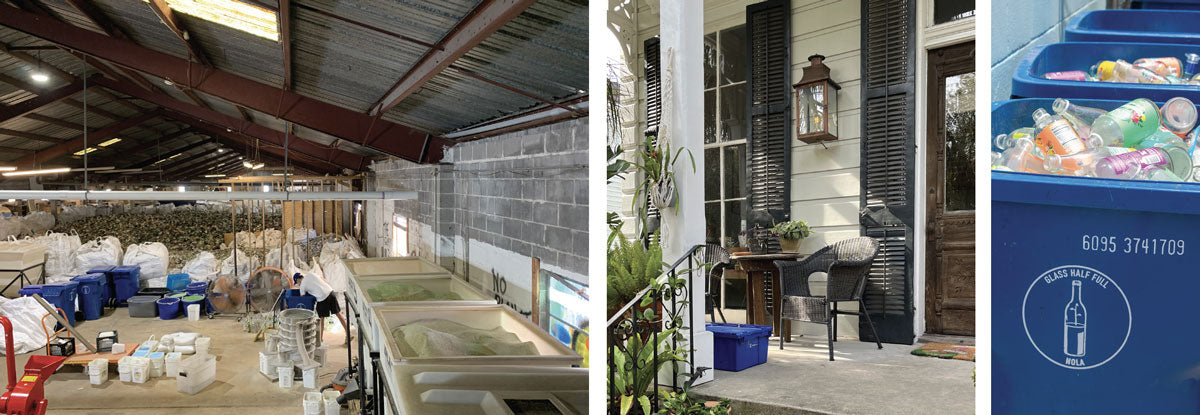Glass Half Full: Recycling Glass Into Sand
By Claire Ferguson

As plentiful as it may seem, the world is facing an alarming shortage of the second most consumed raw material after water: sand. Sand is an essential ingredient for construction, glassmaking, land restoration, and more, but the natural resource is rapidly diminishing. As the world consumes roughly 50 billion tons of sand per year, commonly used extraction processes like mining and dredging are destroying ecosystems, dirtying rivers, and eroding beaches.
Franziska Trautmann, born and raised in New Orleans, lives in an area particularly affected by the loss of coastal shorelines, in serious need of sand to rebuild barriers and combat erosion. Her state of Louisiana not only spends millions of dollars every year importing sand, but also wastes taxpayer money on dumping valuable recyclables like glass into landfills—they pay for every pound that’s discarded.

Frustrated by the wasteful and expensive system, in 2020 Franziska and fellow college senior Max Steitz decided to tackle the problem themselves. They started Glass Half Full, a grassroots recycling program aimed at sustainability and building community. Specifically, they wanted a system that was transparent, accessible, and most importantly, actually recycled glass into something functional.

After starting essentially in a backyard hand-crushing glass into sand, Glass Half Full now provides a free glass recycling drop-off for all Louisiana residents. Local recognition and enthusiastic support from the community grew quickly once word spread about the project.

In Louisiana, as in many states across America, historically low-income communities of color are less likely to have a means of recycling and more likely to be directly impacted by the negative consequences of landfilling and climate change. This organization is able to provide a reliable glass recycling solution to New Orleans that not only reduces the volume of waste sent to landfills, but also opens up educational and economic opportunities to a community that might traditionally be excluded from sustainability initiatives.

“Having to throw away a usable resource can be mentally exhausting and places guilt on the consumer instead of a system that failed to provide the necessary resources. Now, consumers are able to feel genuinely good about themselves for bringing glass to us and seeing the limitless potential for reuse,” Franziska says.

The glass is turned into sand and gravel for coastal restoration, new glass products, sandbags for disaster relief, construction, landscaping, and more. The Glass Half Full team are also continuing to research ways to use the sand to restore coastline, as Louisiana loses 100 yards of land every 100 minutes. Many coastal communities are at the frontline of this loss, and New Orleans is especially vulnerable to tropical storms and flooding due to being below sea level. The recycled sand from Glass Half Full is used to fill sandbags that protect these areas from expensive damages to homes.

Glass Half Full’s work is part of a larger environmental justice movement that seeks to make Louisiana more resilient. “When I’m not dreaming, I hope to play some small part in ensuring we never wake up one morning in the middle of the Gulf of Mexico instead of the middle of New Orleans. I want to show the world that we can be a leader in sustainability, and that we have the ingenuity and motivation to create solutions to our own problems,” Franziska says.
They hope to expand operations to service all of Louisiana’s cities that may benefit from recycled glass and coastal restoration. After moving from the backyard to their first location, they quickly ran out of storage space, but supporters were able to help the organization scale up to a larger processing facility in New Orleans East. The team is growing with staff, volunteers, and community members that all help contribute to the thousands of pounds of glass being saved from the landfill every week.
Recently, they were even able to be on the show Returning the Favor, where Mike Rowe gave them a check for $32,000 to buy a new glass recycling machine. The ongoing support from the community and media attention constantly surprises them and helps the project reach more people than ever imagined.
While the story of Glass Half Full is just beginning, the project’s success shows what incredible change can happen when a community comes together to support a cause they care about.
Learn more at glasshalffullnola.org.
This article appeared in the Beachcombing Magazine May/June 2022 issue.
2 comments
Do you all collect glass from other states like AZ?
Thank you for this great work! I’ve been so frustrated at lack of glass recycling in our state. I live in Shreveport but have friends in the New Orleans area, so I may be hauling my glass to you before you know it!








